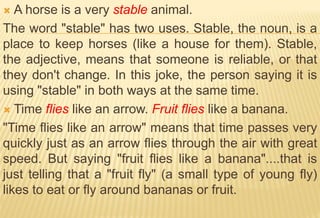Figures of speech ppt
- 1. WELCOME
- 3. TYPES OF FIGURES OF SPEECH ï Under this concept we will learn the following types of figures of speech- ï Simile ï Metaphor ï Personification ï Hyperbole ï Metonymy ï Irony ï Pun ï Litotes ï These are some types of figures of speech but there are many other types of figures of speech also.
- 4. DIFFERENCE BETWEEN LITERAL AND FIGURATIVE LANGUAGE ï Before learning figures of speech, first we have to understand the difference between- ïLiteral ïand ïFigurative ïlanguage
- 5. LITERAL LANGUAGE ï The actual, dictionary meaning of a word; language that means what it appears to mean. ï Avoiding exaggeration, metaphor, or embellishment. ï Conforming to the most obvious meaning of a word, phrase, sentence, or story.
- 6. EXAMPLES OF LITERAL LANGUAGE ï Ex. 1 â The weather is beautiful today. It means what it exactly says, so this sentence is in literal language. ï Ex. 2 â The great Battle of Plassey fought in 1757. It means what it exactly says. So this is in literal language. ïIn other wordsâĶ It means exactly what it says! Word for word.
- 7. FIGURATIVE LANGUAGE ï Language that goes beyond the normal meaning of the words used. ï Based on or making use of figures of speech; metaphorical ï Represented by a figure or symbol
- 8. EXAMPLES OF FIGURATIVE LANGUAGE ï Fragrance always stays in the hand that gives the rose. Does it mean that our hand smells good? NO It means that - Giving to others is gracious and the good feeling of giving stays with you. Here the sentence actual meaning is different and an other meaning is hidden in the sentence, so this sentence is in figurative language. ïIn other wordsâĶ Thereâs a deeper
- 9. ïNow we start our important and interesting concept-
- 10. SIMILE ï A simile is a figure of speech comparing two unlike things, often introduced with the word "like" or "as". ïFOR EXAMPLEâĶ ï Friends are like parachutes. If they arenât there the first time you need them, chances are, you wonât be needing them again. Does this mean that I should jump out of an airplane with my friend strapped to my back? Absolutely not! Friends are being compared to parachutes using the word like.(friends = parachutes). ï Friends and parachutes are dissimilar and unlike each other, yet we have found a way to relate and compare them.
- 11. THE MEANING ISâĶâĶ. ï Parachutes must be there for you the first time you need them or you will fall to your death. If they are not there for you the first time you need them, you will not need them again. Youâll be dead! ï Friends are the same way. If you have a crisis and need your friend to support you, but he doesnât come through, you donât really need that friend for help again.
- 12. METAPHOR ï Unlike simile, metaphor (from the Greek language: meaning "transfer") is language that directly compares seemingly unrelated subjects. ïFOR EXAMPLEâĶâĶ ï A good laugh is sunshine in a house. Does this mean that a laugh is actually light from the sun? Absolutely not! A good laugh is being compared to sunshine by saying that it is sunshine. (laugh = sunshine) A good laugh and sunshine are dissimilar and unlike things being compared to each other.
- 13. THE MEANING ISâĶâĶ. ï Sunshine brings joy and happiness to people. It brightens up a room, a house or where ever its rays strike. ï Laughter does the same thing. It also brings joy and happiness to people and brightens up a room, a house, or where ever it is heard.
- 14. PERSONIFICATION ï Personification is a figure of speech in which human characteristics are attributed to an abstract quality, animal, or inanimate object. ïFor exampleâĶ ï The tree bowed and waved to me in the wind. Does this mean a tree actually recognized I was there and acknowledged me by taking a bow and waving to me? Absolutely not! The tree is being given the human characteristics or actions of waving and bowing. The tree is being personified. It now has character. Again, unlike or dissimilar things are being compared. (tree = person)
- 15. THE MEANING ISâĶâĶ. ï This simply draws the picture in our minds that it must be an extremely windy day for the trees branches to âwaveâ and the trunk to bend as if it were âbowing.â ï The tree is being given the human characteristics or actions of waving and bowing. The tree is being personified. Now it is a character.
- 16. HYPERBOLE ï A figure of speech in which an exaggeration or overstatement is made to illustrate a point is called hyperbole. ïFor exampleâĶ ï Iâm so hungry I could eat a horse! and ï Ten thousand suns light up this room. Does this mean I could actually eat an entire horse or that this room is blindingly bright from actual suns? Of course not! A ridiculous image is being painted in our minds to get the significance and importance of the point across.
- 17. THE MEANING ISâĶâĶ. ï The first obviously means that I am extremely hungry but in no way could I eat a 400 pound horse! ï The second clearly means that our room is extremely bright but in no way will we be blinded by it!
- 18. METONYMY ï Metonymy is a figure of speech in which a thing or concept is not called by its own name, but by the name of something intimately associated with that thing or concept. ï A figure of speech in which a part represents a whole or a whole represents a part.
- 19. FOR EXAMPLEâĶ ï The dagger of the United States sliced Saddam Husseinâs army to pieces. Did just a knife alone destroy Saddamâs armies? Absolutely not! The knife represents a part of the whole United States Armed Forces. (knife = U.S. Armed Forces) ï I pledge my service to the crown. Do I pledge my service to just a crown that sits atop the kingâs head? No! The solitary crown represents a part of the whole king and kingdom to whom I pledge my service. (crown = king and kingdom)
- 20. THE MEANING ISâĶâĶ. ï It means that the armed force or defense force of U.S. won victory against Saddam Hussainâs armed force. ï Next one means that I pledge or serve to whole kingdom and king.
- 21. IRONY ï Irony is a figure of speech in which there is a contradiction of expectation between what is said what is really meant. It is characterized by a contrast between reality and appearance. ï Irony is when one outcome is expected, but the opposite occurs, usually with a coincidental twist of events. ï There are three types of irony : verbal, dramatic and situational.
- 22. TYPES OF IRONY ï Verbal Irony -- Where one thing is said, but another, opposite meaning is inferred. ï Dramatic Irony -- occurs when the audience knows something a character does not and the outcome or meaning is the opposite of what the character expects. ï Situational irony: This refers to the contrast between the actual result of a situation and what was intended or expected to happen.
- 23. FOR EXAMPLEâĶ ï His argument was as clear as mud. It means that the argument is very complex, complicated and disgusting like mud, because mud is also sticky, complicated and disgusting. ï The two identical twins were arguing. One of them told the other: âYou're uglyâ Here both twins are of same faces, so it is a very foolish statement that one brother says ugly to another. ïHere also there is a meaning hidden inside the sentence which doesnât appears clearly.
- 24. PUN ï A pun is a play on words in which a humorous effect is produced by using a word that suggests two or more meanings or by exploiting similar sounding words having different meanings. ï These words are commonly called homophones or homonyms.
- 25. FOR EXAMPLEâĶ ï What is the difference between a conductor and a teacher? The conductor minds the train and a teacher trains the mind. Here train and mind are used as homonyms. âThe conductor minds the trainâ means the conductor take care of train and passengers of train and âa teacher trains the mindâ means the teacher gives training to mind and makes the mind sharp. ï Why do we still have troops in Germany? To keep the Russians in Czech. Here check(examine or inspect) and Czech(Czech republic=a country) are homonyms. So the person is using
- 26. ï A horse is a very stable animal. The word "stable" has two uses. Stable, the noun, is a place to keep horses (like a house for them). Stable, the adjective, means that someone is reliable, or that they don't change. In this joke, the person saying it is using "stable" in both ways at the same time. ï Time flies like an arrow. Fruit flies like a banana. "Time flies like an arrow" means that time passes very quickly just as an arrow flies through the air with great speed. But saying "fruit flies like a banana"....that is just telling that a "fruit fly" (a small type of young fly) likes to eat or fly around bananas or fruit.
- 27. LITOTES ï Deliberate understatement, especially when expressing a thought by denying or negating its opposite. ï Litotes is a figure of speech consisting of an understatement in which an affirmative is expressed by negating its opposite.
- 28. FOR EXAMPLEâĶ ï She is not very beautiful. and ï This is not a small problem. ï In the first example, beautiful is opposite of ugly and then beautiful is negated, making itâs meaning that the girl is ugly. ï In the second example, small is the opposite of big and then small is negated, making the sentence meaning that the problem is big.
- 29. STRUCTURE OF FIRST SENTENCE ï She is not very beautiful. really meansâĶ ï She is ugly. 1.The opposite of ugly is beautiful. 2.Negate beautiful by adding not. 3.Restructure the sentence. ï She is ugly. becomesâĶ ï She is not very beautiful.
- 30. STRUCTURE OF SECOND SENTENCE ï This is no small problem. really meansâĶ ï This is a big problem. 1.The opposite of big is small. 2.Negate small by adding not or no. 3.Restructure the sentence. ï This is a big problem. becomesâĶ ï This is no small problem.
- 31. MADE BY ïA.SHANTANU ïCLASS- ix-B ï ROLL NO.- 27 ïSubject- English ïSCHOOL-K.V. Berhampur, ganjam
- 32. THANK YOU































